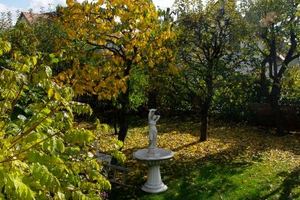Fall is the time to end the growing season and prepare for the next one. One thing to be prepared for in fall is “Mr. Frost.” Vegetables such as tomatoes, peppers, squash, cucumbers, melons and beans are sensitive to frost. You might want to pick these plants before they are damaged by the frost. Frost comes in stages and can occur before the temperature hits 32 degrees Fahrenheit. It leaves a thin film of ice on windshields and withers the tops of leaves.
Covering flowers on evenings you expect a light frost can save those beautiful blooming plants for a few more weeks. If the temperature drops between 28 and 30 degrees, this is considered a hard or killing frost. When you awaken in the morning, the lawn is covered with white crystals leaving the annuals and many perennials looking wilted and discolored. Once fall actually gets here, there are lots of things to do around the yard and garden to clean up. You don’t have to clean up in the fall, but doing so makes your yard and garden look neat and clean.
Once cleanup is done, you will have lots of material for that compost pile. This compost might come in handy next spring. Once the frost gets your annuals and they no longer are blooming and pretty, remove them by pulling roots and all out of the ground. If you are afraid of disturbing the roots of nearby perennials, cut the annuals off as close to the ground as possible. Save yourself money and dig up tender bulbs, rhizomes and tubers. Flowers such as caladiums, callus, cannas, dahlias, elephant ears, gladiolus and tuberous begonias are some of the ones you might want to dig and save. Dig after the leaves start to turn yellow or as soon as they are hit by hard frost.
Once dug, shake off loose soil, let them dry for a week or so. When the tops wither, cut them off. Label them and store them for winter. There are different ways of storing depending on personal preference. One way to store is by rolling them up in newspaper, placing in a cardboard box and putting in the basement. Other ways are by hanging in old nylon stockings, loose-weave baskets or mesh bags. Whatever way you decide, keep them cool, dry and in the dark. Temperatures of 35 to 45 degrees Fahrenheit in a well-ventilated area is best. You might consider dusting them with an all-purpose garden dust to ensure against insect and disease damage while in storage. Heavy stalked perennials (coneflower, rose mallow, etc.) can be left in the garden as long as they look nice or until the next spring.
Once you do decide to clean them up, cut them off at ground level. Weaker perennials (bellflowers, anemones, etc.) get shabby, limp and mushy. It might be a good idea to clean these up right away. If they fall over while wet and mushy, they might rot the plant. Ornamental grasses will last into the winter. There is no need to do anything with them until they start to fall over or start shedding strawlike bits which blow around in your yard. At this time, cut them down. Leave them only a few inches high. Evergreen perennials that stay semi-green all winter do not need to be pruned.
Just cut off old flower stalks and yellowing parts. Ferns do not require much, work. Let them die and fall
over. This will form the perfect mulch for themselves. Raking leaves can be a big job if you have a lot of trees. Running over them with the lawn mower or putting them through a shredder can reduce the bulk. Shredded leaves can be a good source of mulch. Two to 6 inches of leaves around your bushes and perennials makes a nice mulch. If you opt for a different type of mulch, put those leaves on your compost pile.
Fall is a great time to plan for spring. Start a list or draw a map of your garden. This will help you keep track of where your different plants are and what colors they are. Next, spring, this might come in handy when you go to plant new flowers and you can’t remember what color mum you are planting that purple coneflower beside. Look over your garden and analyze it. What did you like best? What did you like least? What can you do to improve it next spring? Plant those spring bulbs. Add to your tulips, crocus, daffodils, hyacinths and other spring flowering bulbs.
Once your fall cleanup is finished – clean up those tools! Clean the soil off of the shovels and other tools. Sharpen dull-edged blades. Put a light coat of oil on metal tools to prevent rusting. Drain the gas from lawn mowers, weed trimmers and other tools. Store everything away nice and neat for next season.
http://plantanswers.tamu.edu/fallgarden/fallindex.html
